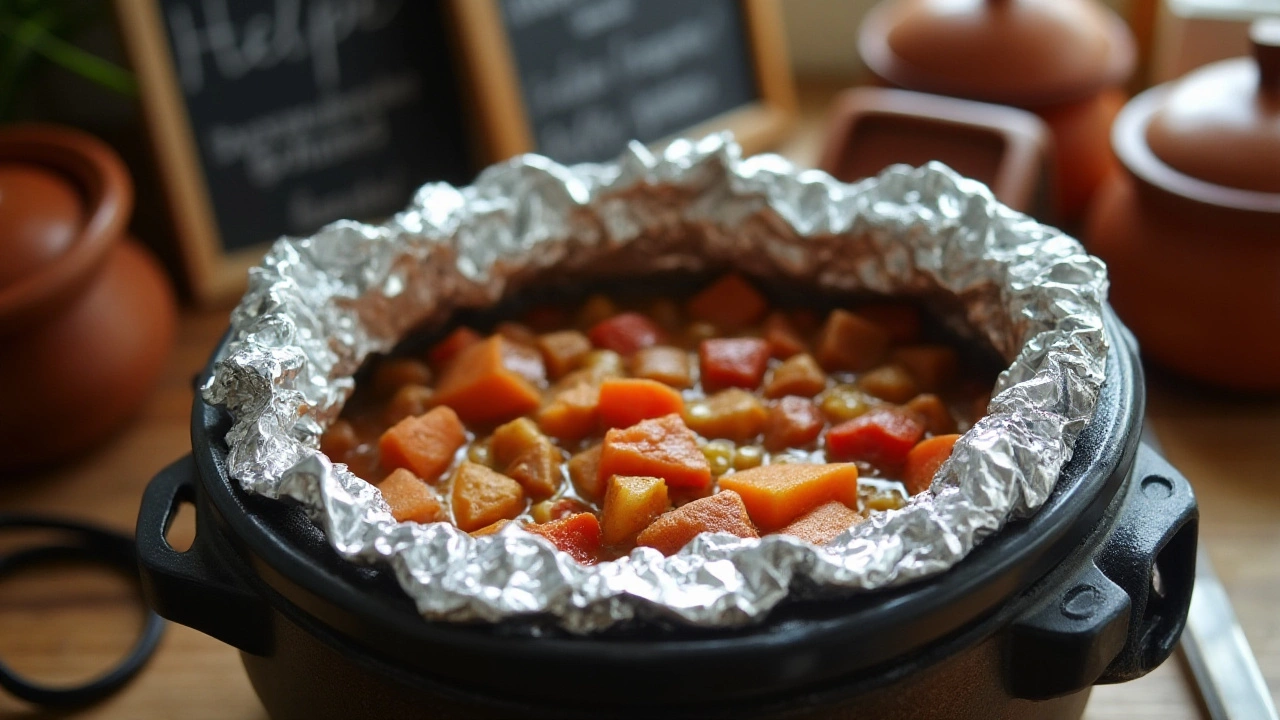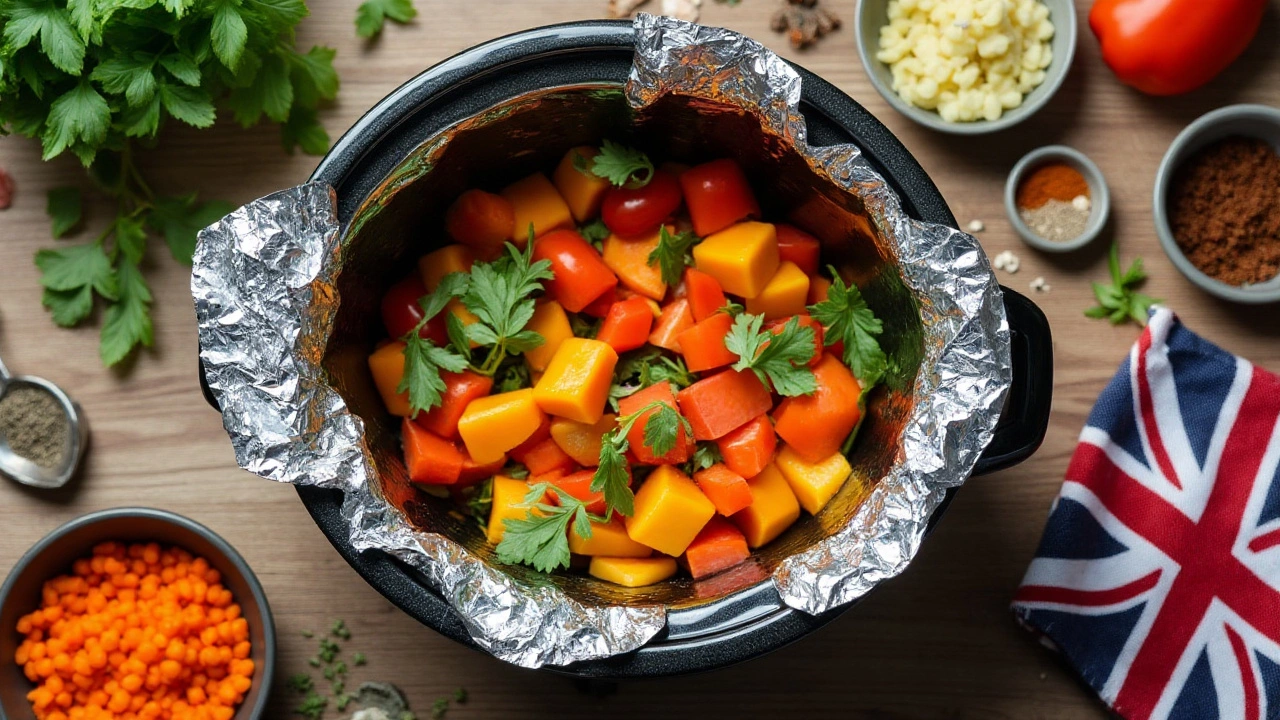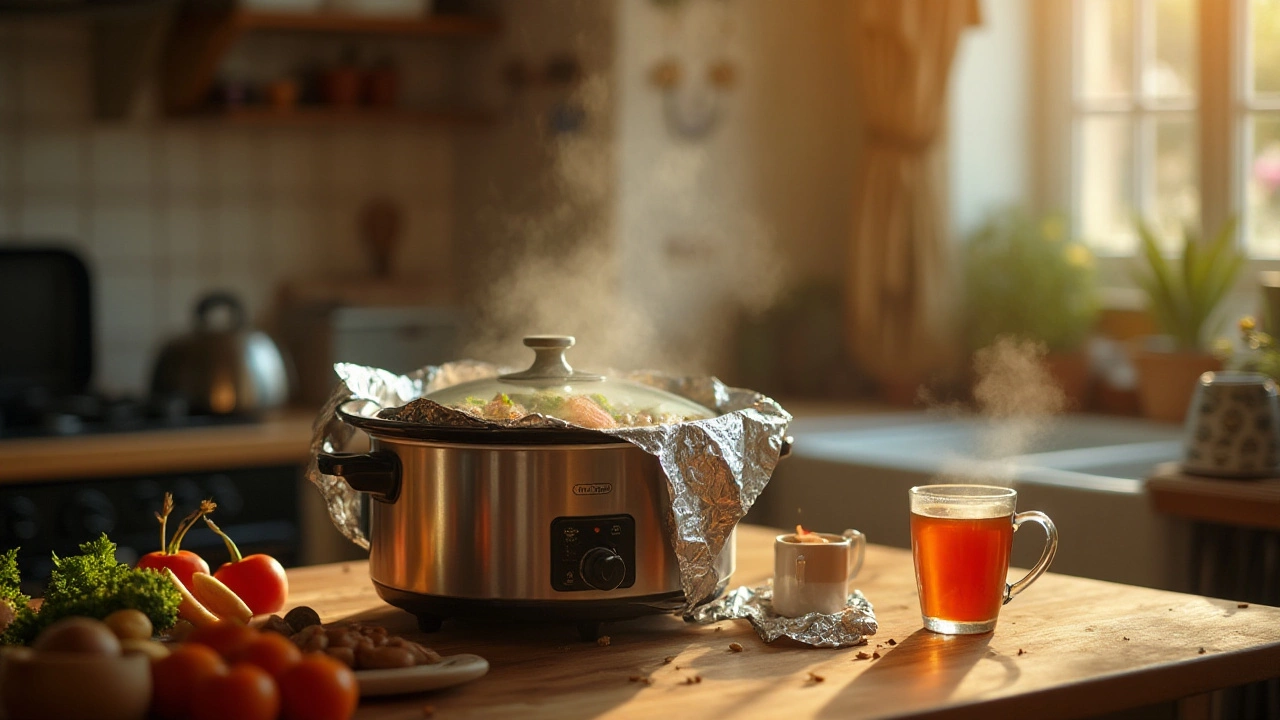Whether you're a seasoned pro or just started dabbling with slow cooking, the question of using aluminum foil often arises. It's that shiny kitchen staple sitting comfortably in drawers, yet its use isn't always straightforward. Foil in a slow cooker? Sounds dubious at first, doesn't it? But quite the contrary, using aluminum foil in this trusted appliance can open up a world of cooking possibilities, with the key word being 'safely'.
From savvy tricks for seamless clean-up to creative cooking methods that transform humble ingredients, foil can be a trusty companion in your slow cooking adventures. But, like any kitchen tool, it's crucial to wield it with care and knowledge. So stick around as we dive into the ins and outs of using aluminum foil safely and effectively in your slow cooker, ensuring those delectable dishes turn out just right.
- The Basics of Cooking with Aluminum Foil
- Safety Considerations for Slow Cooker Use
- Creative Uses of Foil in Slow Cooking
- Tips for Easy Cleanup
- Common Mistakes to Avoid
The Basics of Cooking with Aluminum Foil
In the culinary world, aluminum foil is a bit of a jack-of-all-trades. Its versatility makes it a staple in kitchens around the globe, especially when it comes to using it in conjunction with a trusty slow cooker. The foil can act as both a barrier and a facilitator, helping to regulate cooking times and keep flavors tightly sealed inside.
Let us start with the simplest applications—using aluminum foil to wrap ingredients. This technique helps trap heat and moisture, ensuring that food cooks more evenly. But it's not just about retaining the warmth; it's about creating these mini steam chambers that coax out tenderness and keep dishes succulent. For example, when cooking something like chicken breasts, wrapping them in foil can prevent them from drying out and infuses the meat with whatever herbs or flavors you included. This method encourages a more even heat distribution as well, cutting down on those annoying cold spots.
A less obvious, yet equally effective, use of foil is as a makeshift divider in your slow cooker. Imagine wanting to prepare two separate dishes at once—foil can be folded to create a physical barrier, allowing you to cook a sweet and savory dish simultaneously without the fear of cross-contamination. It's a space-saving hack that fits snugly into today’s busy lifestyle. Also think about the ease of arranging vegetables at the bottom layer for slow, consistent cooking.
Another interesting angle on foil in slow cooking is its reflection properties. Aluminum foil reflects heat, which can slightly increase the efficiency of cooking times in certain scenarios. This isn't always the most critical factor, but in a pinched scenario or a busy day, every little bit of efficiency helps. Moreover, consider the neat trick of creating a foil collar. By wrapping a strip of foil around the rim of the pot, unexplained heat loss can be minimized, ensuring whatever is cooking doesn't end up with burnt edges. Ray Pfieffer, a cooking enthusiast, once said, "The magic of aluminum foil lies not in its presence but the creativity it inspires for enhancing each dish you make."
Beyond cooking, aluminum foil can be handy for cleaning post-cooking. Crafting a little foil ball can help scrub away stubborn residues without scratching your cooker. It's small insights like these that can turn a good dish into a great memory, made effortlessly with the help of aluminum foil.
The next time you reach for that iconic roll of aluminum foil, you’ll appreciate the opportunity it brings. Not merely a sheet of metal, but a multi-functional tool that is as adaptable as the recipes it helps bring to life. Whether it’s improving taste, cutting down prep, or cleaning time, these simple sheets hold far more potential than you might expect.
Safety Considerations for Slow Cooker Use
When it comes to using aluminum foil in a slow cooker, safety should be your top priority. It's important to remember that slow cookers are designed to cook food slowly at a low temperature over a long period. This method retains moisture but also calls for careful consideration to prevent accidents. One major concern with foil is the potential for chemical reactions or the risk of food contamination if used improperly. While aluminum foil is FDA approved for cooking, adherence to guidelines is key. Wrapping foods or creating dividers with foil can enhance your cooking experience, but knowing the right way to do it matters.
There’s a chemistry component to this as well. The acids in foods can break down aluminum foil, which could potentially make its way into your meal. So, it’s advisable to avoid contact between foil and highly acidic foods like tomatoes or vinegar-based marinades. A good tip is to place a layer of parchment paper between the food and the foil as a barrier. If you're using foil to create a separation or barrier within your slow cooker, ensure it is secured snugly and not floating loosely, to prevent bits from sticking to your food or, worse yet, getting stuck in the meal itself.
Temperature and Electrical Safety Tips
Before placing any foil in your slow cooker, it is important to ensure the cooker itself is in good working condition. Check the temperature settings and ensure the heating element functions properly. Slow cookers are built for lower heat, but trapping excessive heat with foil can sometimes create uneven cooking conditions. Always remember that the sealed environment can harbor steam, so it's wise to handle the slow cooker and its lid with care to prevent burns. Make sure your unit maintains the correct simmering temperature of around 85°C (185°F) without the foil obstructing the heat flow. Some reputable chefs suggest using a thermometer to verify that the slow cooker hits and maintains safe temperature zones.
"Using foil in a slow cooker is fine for many dishes, but you have to be mindful of how much heat it reflects back. It’s all about balance and keeping a close eye on your dish,” says culinary expert Jane Lawson.
With these safety tips in mind, the slow cooker remains a fantastic kitchen tool, and incorporating foil is just one more way it adapts to your culinary creations. Whether you’re cooking a savory pot roast or a sweet dessert, bear in mind that even a small oversight could impact your meal’s success and safety. By following these guidelines, you’ll cook delicious meals while ensuring the slow cooker continues to be a safe and reliable part of your kitchen oeuvre. Always keep safety at the forefront and enjoy the process of slow-cooked perfection.

Creative Uses of Foil in Slow Cooking
Have you ever thought about how a simple piece of aluminum foil could transform your slow cooking experience? It's a culinary secret many budding chefs overlook. Using foil, not only can you separate different ingredients cooked simultaneously, but you can also create different textures and tastes that delight the palate. Imagine cooking a moist chicken breast over a bed of vegetables without them getting soggy. Simply fashion a neat foil packet around your chicken before placing it atop the veggies. This method keeps the juices locked in, while the veggies gently steam below. It's innovation wrapped in simplicity and perfect for those days when you want a refined meal without much fuss.
Now, think about desserts. Slow cookers aren’t just for savoury masterpieces. Use aluminum foil to create a water bath ideal for baking delicate desserts like custards and cheesecakes. Wrap the outer rim of your baking container with foil before nestling it in a pool of water inside the slow cooker; this method distributes heat evenly, preventing cracks. You'd be amazed at how a slow-cooked cheesecake matches oven-baked ones, if not surpasses them in creaminess. Plus, there's less heat wafting through the house—ideal when it's sweltering outside.
Foil Dividers: Cooking Multiple Dishes
Indeed, one might say foil is the magician's wand of the kitchen. You can use it to create compartments in your slow cooker. By fashioning thicker pieces of foil into 'tent-like' structures, you turn a single vessel into a multi-dish powerhouse. Cook sides like rice or grains in one section and juicy meats in another. It’s like having two slow cookers in one. This hack is perfect for parties or meal prepping, providing a way to keep flavors distinct while making the most of your appliance.
"I can’t imagine cooking without my slow cooker and foil. It’s a combination that turns simplicity into sophistication," says culinary expert, Martha Stewart.
These instances reveal how versatile your slow cooker can be, thanks to a little bit of foil. And yet, many are unaware of these methods. The beauty of it is that it caters to both novice cooks and seasoned pros alike, inviting anyone to innovate and save time. A helpful tip is to always use heavy-duty foil to ensure it retains its shape and doesn't tear while cooking, preserving the integrity of your dish. Keep experimenting, and you might just stumble upon a new favorite method in the process.
Tips for Easy Cleanup
Let's face it, one of the joys of using a slow cooker is the promise of a hearty meal with minimal fuss. Yet, the thought of scrubbing off the stubborn residues left after a long cooking session can be daunting. Enter the humble aluminum foil, an unsung hero for those longing for quick clean-ups. Lining the walls and bottom of your slow cooker with foil can act as a protective shield against drips and burnt-on bits, leaving you with nothing but deliciousness and a clean pot at the end of the day. This trick can transform what would typically be a lengthy babysitting engagement with soap and sponge into merely a quick rinse before storing the pot away. Just be sure to leave your slow cooker liner slightly open at the top to avoid the foil playing an uninvited guest role by interrupting the cooking process.
Another delightful hack using foil involves creating packets or 'pockets' inside the slow cooker. Imagine being able to section off ingredients like fish or vegetables into individual servings, wrapped and cooked separately within the same pot. This keeps sauces and juices from merging into a single conglomerate, offering a sort of multi-course meal without intermingling flavors. Kids love it too—when visually partitioned, each bundle becomes a surprise package at the dining table, revealing its contents only when the foil is peeled back. However, always ensure your packets are tightly sealed to maintain moisture and prevent leakage. A word of caution from the culinary folks at Test Kitchen: "Using foil packets with acidic foods, like tomatoes or citrus, should be approached sparingly due to their potential to react with aluminum."
Foil is not merely a liner but can be rolled into sturdy ropes or balls to create a makeshift rack. This rack is convenient when you're trying to elevate a roast or poultry above accumulated juices to prevent sogginess—a common enemy when seeking that desired crispness on the outside of your dish. For added effectiveness, you can cross-layer the foil up and around the meat, almost acting like a basket that allows air circulation, which is perfect during the dry-pasta lasagna or layered casseroles. The balance between cooking within its own juices while keeping the meat elevated comes naturally with a few rope tweaks here and there. Remember, making a ball of foil too dense can block the efficient heat flow, so fluff it a little to unleash its full potential.
"Cleaning becomes a pleasure when innovation steps into your kitchen—foil is not just shiny, it's genius in disguise," says author and home-cook Lucy Howl.
Getting crafty with foil can mean the difference between enjoying your slow-cooked meal with family and dreading the pending dish duty. Crucial yet overlooked, these kitchen hacks become second nature once incorporated into your slow-cooking routine, leaving little room for clutter and making more time for savoring your creations. Above all, remember to exercise attention and creativity to achieve the finest results safely. And who knows, maybe you’ll find yourself sharing these innovative tips the next time someone asks about making cleanup as simple as pie.

Common Mistakes to Avoid
It's truly exciting to experiment with new techniques in the kitchen, but when it comes to using aluminum foil in a slow cooker, certain pitfalls should be sidestepped. One frequent mistake is covering the entire cooking surface with foil. While it might seem appealing to line everything for easy clean-up, this tactic can steer your meal astray. Blocking the flow of heat can affect the cooking process, leading to unevenly cooked dishes. In turn, your veggies might be mushy, or that roast could emerge tough. The secret lies in striking a balance, allowing the foil to aid rather than hinder.
Another blunder to watch for is wrapping meats too tightly. As tempting as it is to tightly cocoon meats like a bedtime burrito, it can leave juices trapped with nowhere to escape. This oversight often results in a steam bath for your dinner, altering textures in ways less than delightful. Instead of precision-roasted chicken, you might meet a soggy reality. By wrapping loosely, you allow steam to escape, keeping textures where they should be. Remember, proper ventilation is your friend in cooking, fostering both flavor and consistency.
Miscalculating cooking times presents another hurdle. Unlike conventional ovens where you might have more leeway, a slow cooker's methodical pace demands precise timing. Adding aluminum foil can further complicate this equation. The foil will insulate heat, potentially hastening cooking time or altering it unpredictably. Failing to adjust your timing to account for the presence of foil could transform a meal meant to simmer into an overdone fiasco. Carefully timing slow-cooked recipes with foil in the mix is essential, allowing the flavors to meld perfectly without over or undercooking.
Ignoring the impact on flavor is also a common lapse. Aluminum foil can influence the taste of your meal, sometimes in ways you didn't intend. In acidic dishes, like those with tomatoes or citrus, the foil might react, imparting an undesirable metallic taste. Opting for parchment paper in such cases could be a better choice, maintaining the intended flavor profile of your dish. It's essential to think about the type of meal you're preparing and how materials might influence the outcome. By considering these subtleties, you ensure that each dish reaches its full potential of deliciousness without unexpected off-notes.
"The key to mastering cooking is understanding the interaction of food, heat, and time," noted culinary expert Harold McGee, highlighting the need for meticulous attention.

